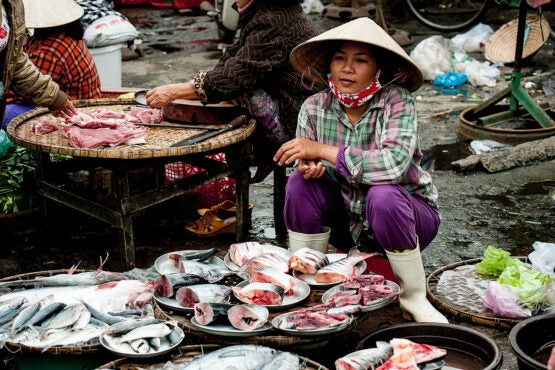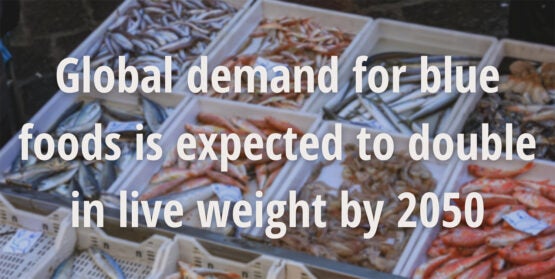Stanford-led study suggests rising and shifting demand for seafood by 2050
Humanity is likely to consume more fish and shellfish in the coming decades. Preparing for that future requires better data on the types of fish that people eat, sustainable expansion of aquaculture and improved understanding of the local context for the food on our plates.
What will humans eat in 2050? A lot more fish, new research suggests. The study’s authors estimate global fish consumption by midcentury will increase nearly 80 percent and the total weight of the world’s fish harvest as it comes from the water – shells, guts, bones and all – may nearly double. A confluence of factors including population growth and local changes in affordability, trade and culture are behind the projected increases.
While rising incomes have helped to fuel demand for meat in recent decades, fish and shellfish, which researchers have dubbed “blue foods,” don’t fit quite as neatly into the conventional economic model of income-driven demand for animal products.
“A main result of the paper is that wealth and blue food consumption are not tightly coupled. You don’t see people eating more fish overall as they get richer, but the types of fish they eat may change. At low incomes, people consume more blue foods if they’re affordable. At high incomes, people eat fish if they have some sort of preference for it: health, or sustainability or just taste,” said lead study author Rosamond Naylor, the William Wrigley Professor of Earth System Science at Stanford University.
One likely explanation for the disconnect, the authors say, is that “fish” is such a vast category, encompassing thousands of species caught or farmed across the planet’s oceans, lakes, rivers and backyard ponds, or cultivated in land-based tanks and raceways. And the things that shape fish consumption patterns – food traditions, nutritional knowledge, availability of plant-based meat substitutes and more – vary from place to place and evolve over time.
Published Sept. 15 in Nature Communications, the new results “emphasize the need for local, context-specific food and nutrition security policies,” said study co-lead author Shakuntala Thilsted, a nutrition and public health expert with the Malaysia-based international research organization WorldFish and the 2021 World Food Prize Laureate.
Changing tastes
The environmental and health impacts of the projected rise in fish consumption will depend on the types and methods of aquaculture that expand to meet new demand – and on how the mix of proteins on our plates changes.
It wouldn’t be the first time people’s preferences for animal products have changed: poultry has already become a “major substitute for beef in global diets,” the authors write. While consumption per capita of beef has declined since the 1960s, that of seafood has more than doubled and poultry has increased five-fold.
“We have a tremendous opportunity to bring species to market that are both environmentally sustainable and nutritious,” said Naylor, who is also a senior fellow at the Stanford Woods Institute for the Environment.
Bringing species to market, however, is only half the battle. Bivalves such as oysters, clams and scallops have been held up as a sustainable seafood option that can contribute to shoreline protection and cleaner water – but it remains to be seen whether people’s tastes will change enough to boost demand for these creatures as food relative to other types of seafood and meat.
Missing data
Records of the food that people actually eat, rather than the amount of food that is produced or available for purchase, are scant. The authors found national surveys seeking to estimate the current consumption of blue foods tend to produce conflicting results. They often ignore fish eaten outside the home – leaving a particularly gaping hole in understanding the role of urbanization in driving blue food demand – and fail to capture prices and types of fish consumed.
“We need consistent surveys across countries. Without fully understanding the demand side of the puzzle, policy recommendations will be based on faulty assumptions about which blue food species consumers already prefer,” said Naylor.
To overcome the lack of data, the researchers analyzed previously published research and food supply data from the UN’s Food and Agriculture Organization (FAO) for 72 countries that together account for 80 percent of all blue food consumption worldwide. They also analyzed regional demand for the largest consuming nations within each continent and combed through data for four specific countries – China, India, Nigeria and Chile – in more detail to investigate the roles of income, trade, geography, culture and preferences in “blue food” demand.
The degree to which oceans and freshwater systems will be able to keep up with the predicted changes in demand will be closely linked to global climate change, which the authors say is likely to drive up seafood prices and disproportionately impact the poor. The need to bolster preparedness has been laid bare by the disruption of the COVID-19 pandemic, which saw widespread closure of ports and seafood processing facilities throughout Asia and, early in 2020, a near-total collapse of the restaurant market for farmed oysters and other molluscs.
According to the study, one important step will be gathering better data on household consumption and prices of not only fresh fish but also dried, salted or otherwise processed fish that allows for storage and long-distance trading. “Much improved data,” the authors write, “are urgently needed to ameliorate the impacts of shocks, including pandemics and climate change, on vulnerable populations.”
This paper is part of the Blue Food Assessment, which was supported by the Builders Initiative, the MAVA Foundation, the Oak Foundation and the Walton Family Foundation.
Naylor is also founding director of Stanford’s Center on Food Security and the Environment, a senior fellow at the Freeman Spogli Institute for International Studies and a professor (by courtesy) of Economics. She is a member of the Forest Protection Advisory Panel at Cargill, the Scientific Advisory Board for Oceana and the President of the Board of Directors for the Aspen Global Change Institute.
Additional co-authors are affiliated with the International Food Policy Research Institute (IFPRI) in New Delhi, India; University of British Columbia in Canada; Michigan State University; Wageningen University in The Netherlands; Shanghai Jiao Tong University in China; Pontificia Universidad Católica de Chile in Chile; American University; Harvard T.H. Chan School of Public health; Royal Swedish Academy of Science in Sweden; and University of Stirling, United Kingdom.


